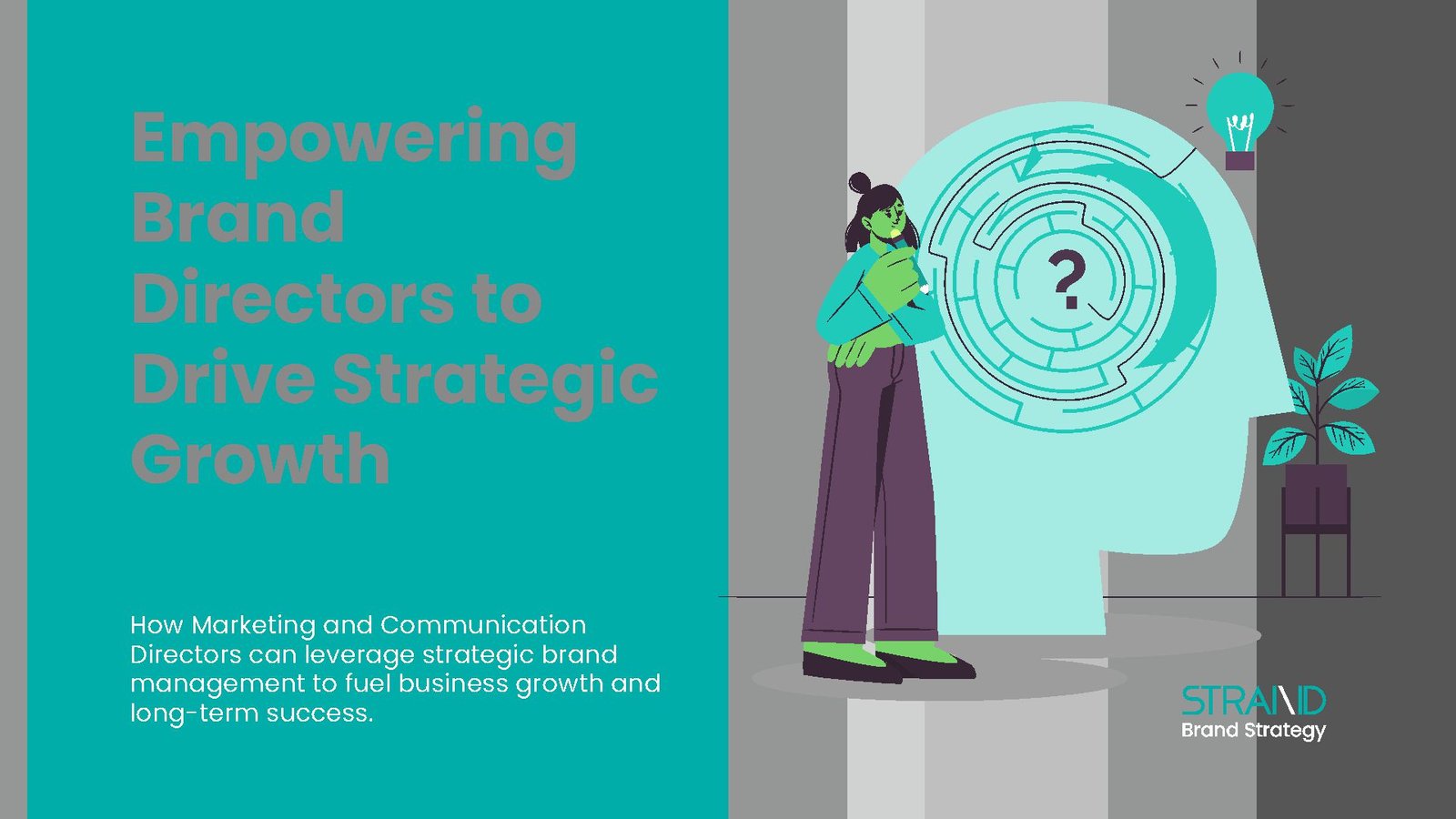Empowering Brand Directors to Drive Strategic Growth
7 minutes | 01 Nov 2024How Marketing and Communication Directors can leverage strategic brand management to fuel business growth and long-term success.
In today’s fast-paced, digitally-driven marketplace, marketing and communication directors face immense pressure to not only increase brand awareness but also to drive measurable business growth. Their roles have evolved beyond traditional marketing functions; they are now key decision-makers responsible for ensuring that brand strategies are deeply integrated with overall business objectives. Whether managing mid-sized or large businesses, these professionals are tasked with delivering a cohesive brand message, optimizing customer engagement, and implementing data-driven marketing tactics that contribute to both short-term wins and long-term success.
As the competition intensifies, especially in sectors undergoing rapid digital transformation, the ability to create a strong, resonant brand has become essential for staying relevant. Marketing and communication directors must not only understand the intricacies of consumer behavior but also be adept at aligning internal stakeholders and external messaging to ensure a unified brand presence.
This article explores the critical role marketing and communication directors play in driving strategic brand growth. It outlines key trends, challenges, and effective strategies to elevate brand performance in today’s evolving market landscape.
The Role of Marketing and Communication Directors in Strategic Brand Growth
Definition:
Marketing and communication directors are senior executives responsible for shaping and executing a company’s brand and communication strategies. Their role entails overseeing brand positioning, customer engagement, corporate messaging, and the alignment of marketing initiatives with business goals.
Current Trends/Data:
According to a survey by McKinsey, 80% of CEOs believe their marketing leaders should be growth drivers rather than just brand stewards. As brand-building increasingly shifts to the digital space, marketing directors are expected to blend creative thinking with data analytics to deliver measurable business outcomes. A recent Deloitte report also highlights that companies with a well-defined brand strategy are 67% more likely to exceed revenue expectations.
Implications:
The implications for marketing directors are profound. To succeed, they must not only be custodians of brand equity but also drive customer acquisition, retention, and revenue growth. Furthermore, as consumer preferences shift towards personalization, sustainability, and digital experiences, marketing directors must adopt strategies that resonate with these evolving demands.
Examples:
Procter & Gamble (P&G) offers a strong example of how marketing leaders can fuel brand growth. P&G’s marketing directors focus on data-driven insights to personalize their product messaging and meet consumers’ specific needs. This approach has helped the company maintain its leadership in the consumer goods market while innovating to stay ahead of competitors.
Challenges Facing Marketing and Communication Directors Today
Factors/Drivers:
Marketing directors today face a range of challenges that can hinder their ability to drive strategic growth. Key drivers include rapid digital transformation, the need for customer-centric marketing, and heightened competition in both local and global markets.
- Digital Disruption and Data Overload:
With the explosion of digital channels, marketing directors are under increasing pressure to create integrated strategies across platforms such as social media, content marketing, search engine optimization, and digital advertising. However, the sheer volume of data generated from these channels can be overwhelming, making it difficult to derive actionable insights that enhance brand performance. - Consumer Behavior Shifts:
Consumers today expect personalized, on-demand experiences across every touchpoint. A study by Accenture shows that 91% of consumers are more likely to shop with brands that recognize, remember, and provide relevant offers. Hence, failing to meet these expectations can result in lost customers and weakened brand loyalty. - Internal Alignment and Budget Constraints:
Marketing directors often struggle with aligning their marketing strategies with the overall business vision and getting buy-in from other departments such as sales, product development, and finance. Additionally, budget constraints can limit the ability to invest in new technologies, talent, and campaigns that drive innovation.
Challenges/Opportunities:
These challenges also present opportunities for marketing and communication directors to reposition themselves as strategic leaders within their organizations. By mastering the art of data-driven marketing, leveraging technology to enhance customer engagement, and aligning internal teams around shared brand objectives, marketing directors can overcome these hurdles and unlock growth potential.
Stakeholder Impact:
Marketing directors must engage with multiple stakeholders—including the C-suite, customers, and internal teams—while ensuring that every piece of communication reinforces the company’s brand positioning. Without this alignment, brand efforts may become fragmented, diminishing their overall effectiveness.
Examples:
A well-known example of overcoming marketing challenges is Unilever. Despite operating in a highly competitive market, Unilever’s marketing directors have embraced digital transformation, using data analytics to sharpen brand messaging and align their campaigns across various regions. This focus has allowed them to deliver personalized experiences while maintaining a consistent global brand presence.
Strategies for Marketing and Communication Directors to Enhance Brand Growth
Proposed Solutions:
To navigate the challenges of modern marketing and drive sustained brand growth, marketing and communication directors must embrace innovative strategies. Here are key tactics for success:
- Integrating the 5S Framework for Strategic Alignment
STRAND’s 5S Framework offers marketing directors a comprehensive guide for developing and executing brand strategies:- Aspirations: Clearly define the brand’s long-term vision and values. Align marketing objectives with broader business goals to ensure every campaign drives measurable results.
- Analyses: Use STEEPLE analysis to understand external factors (social, technological, economic, environmental, political, legal, and ethical) that impact your market positioning.
- Alignment: Foster collaboration between marketing, sales, product development, and finance teams to ensure a unified approach toward brand building.
- Awareness: Develop customer-centric campaigns that build brand awareness across digital and traditional channels. Leverage data analytics to fine-tune messaging for each audience segment.
- Actions: Implement agile marketing strategies that allow for quick adaptation to changing consumer behaviors and market dynamics.
- Leveraging Data-Driven Marketing
In a data-rich environment, marketing directors must therefore embrace analytics to understand customer preferences, track campaign performance, and optimize marketing spend. This approach allows for more precise targeting, helping to deliver personalized experiences at scale. By integrating Customer Relationship Management (CRM) tools and Marketing Automation Platforms (MAPs), directors can collect actionable insights and drive higher ROI on marketing investments. - Building Digital-First Brand Strategies
Given the dominance of digital channels, marketing directors need to prioritize a digital-first approach. This includes investing in SEO, content marketing, social media engagement, and influencer partnerships to enhance brand visibility. Ensuring that digital touchpoints—from websites to social media profiles—offer a seamless user experience will also contribute to stronger brand loyalty. - Sustainability and Purpose-Led Branding
Consumers are increasingly gravitating towards brands with a clear sense of purpose and a commitment to sustainability. According to a Nielsen report, 66% of consumers are willing to pay more for sustainable brands. Marketing directors must ensure that sustainability initiatives are authentically integrated into their brand messaging to resonate with socially-conscious consumers.
Case Studies:
A notable example is Nike, which has redefined its brand by embracing a digital-first approach, combining data analytics with purpose-led campaigns. Their marketing directors have spearheaded initiatives like the “Just Do It” campaign, which not only aligns with the company’s mission but also sparks conversation around social and cultural issues. This has resulted in increased brand equity and stronger consumer loyalty.
Future Outlook:
As technology continues to evolve and consumer behaviors shift, marketing and communication directors must remain agile in their approach. Hence, The future of brand growth will be driven by personalization, automation, and the ability to integrate advanced technologies like artificial intelligence (AI) into marketing strategies. Directors who stay ahead of these trends will be well-positioned to lead their companies toward long-term success.
Marketing and communication directors are no longer just brand stewards; they are strategic growth drivers who play a critical role in aligning brand strategy with overall business goals. By leveraging frameworks like STRAND’s 5S model, embracing data-driven marketing, and focusing on customer-centric and purpose-led campaigns, marketing directors can enhance brand performance in an increasingly competitive market.
Moreover, digital transformation, personalization, and sustainability will continue to shape the future of marketing. Directors who invest in these areas while maintaining a clear focus on their brand’s long-term aspirations will not only meet today’s challenges but will also create lasting value for their organizations.
Want to elevate your brand strategy and drive measurable growth? Contact STRAND for a personalized consultation and strategic brand workshop tailored to the needs of marketing and communication leaders.

